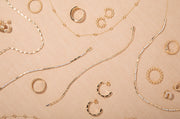Brain Teaser of the Day: Carat vs. Karat! It’s always tricky when two words are pronounced the same way yet mean completely different things. Understanding the difference between carat and karat can help make informed decisions when purchasing fine jewelry. Let's clear up any confusion by breaking down both of these important jewelry terms while exploring how they relate to the good stuff: sparkle and glow, aka, diamonds and gold!
Why the Confusion Between Carat and Karat?
The confusion between carat and karat arises because the two words sound identical but have different meanings in jewelry and when discussing precious metals.
-
A carat (ct) is a unit of weight (not purity) used to measure diamonds and gemstones.
-
A karat (K) is a measurement of the purity of gold (not weight).
What is a Carat?
A carat is a unit of measurement in which:
-
1 carat = 200 milligrams (0.2 grams)
-
1 carat = 100 points.
-
For example, a .50-carat diamond is often called a “50-point” diamond.
A carat measures the weight of a diamond, not the size. Two diamonds of the same carat weight may appear different in size depending on their cut and shape.
How Carat Affects Diamond Size and Value
We know that a carat measures the weight of a diamond while the diamond’s overall size has a variety of other factors in play.
The size of a diamond depends on the diamond’s cut, shape, and proportions. The use of carats helps jewelers determine the diamond's weight accurately.
Diamond prices are based on the 4Cs (Carat, Cut, Color, Clarity). Carat weight has a major impact with higher carat diamonds being exponentially more expensive. There are price jumps at key weights, for example, a 0.99-carat diamond costs much less than a 1.00-carat diamond, even if they look almost identical.
What is a Karat?
A karat is a unit of measurement that indicates the purity of gold in an alloy (mixture of metals).
Gold is often mixed with other metals (like copper, silver, or zinc) to make it more durable The karat value in an alloy represents the proportion of gold.
Pure gold is 24 karats, meaning it is 100% pure.
How Karat Impacts the Quality and Value of Gold
The higher the karat the more gold content. This sounds like a good thing - which it is - but it’s important to keep in mind that pure gold is softer and, therefore, more prone to scratches.
The lower the karat, the less gold content. However, because of the addition of other metals, it’s more durable and less prone to bending and scratching.
Higher-karat gold is more expensive than lower-karat gold because of its higher content of pure gold. Gold prices are based on weight and purity, so 24K gold costs more per gram than 18K or 14K gold. Gold jewelry crafted with 24 karat gold is considered of the highest purity but is much softer and less durable.
How Carat and Karat Impact Jewelry Decisions
When choosing jewelry, both carat (weight) and karat (purity) play a crucial role in determining appearance, durability, and value.
A larger carat stone will be more expensive, but this option is not always the best choice.
A smaller, well-cut diamond can appear bigger and more brilliant than a poorly cut one. Some diamond shapes appear larger than others even with the same carat weight (Tik Tok where we explain this).
Higher karat gold (22K-24K) is more valuable and more expensive, but it is softer and more prone to damage.
Lower karat gold (10K-18K) is stronger and more durable, making it the most ideal option for everyday jewelry.
Choosing Diamonds Based on Carat Weight
When selecting a diamond, carat weight is important, but it should be considered alongside cut, clarity, and color – value is important. All of these things are a factor in appearance – at the end of the day, you want to love gazing at your gorgeous stone.
Keep in mind, carat represents the weight and not size. A well-cut diamond may appear larger (the power of illusion at play!) than a poorly cut one of the same carat weight.
Selecting Gold Jewelry Based on Karat Purity
When selecting the karat purity of gold jewelry to purchase, consider the purpose of the piece. If purchasing an everyday piece of gold jewelry, a lower karat is better because it will be less expensive and more durable because of the addition of other metals.
Pure gold (24K) will be the most expensive while also being the softest, so it is better for investment pieces that are only worn occasionally.
Hope you’re feeling informed and inspired! If you have additional questions, please reach out - we love connecting and could discuss the technicalities of jewelry all day, everyday! There are so many things to consider when investing in jewelry. The most important takeaways: buy what you love and invest in a quality piece created by people you trust. It’s also vital to be well informed about your purchase but don’t forget to have fun. There is a serious component when purchasing jewelry but it should also be a lighthearted experience, full of joy!





